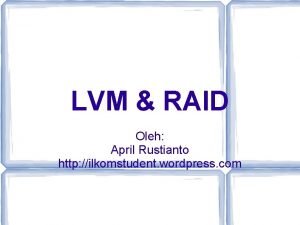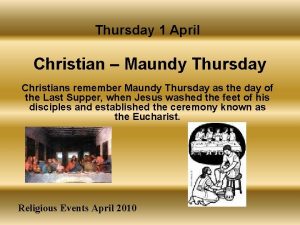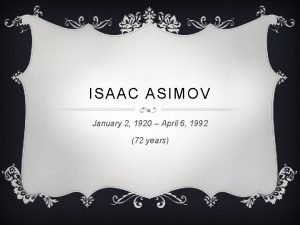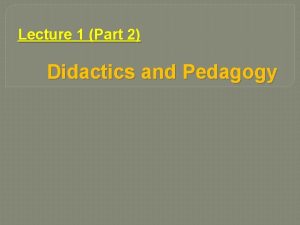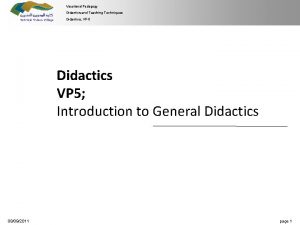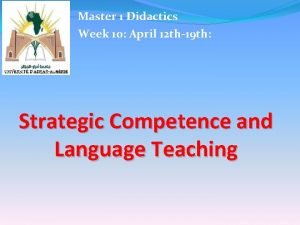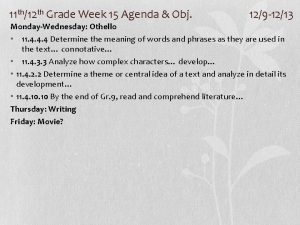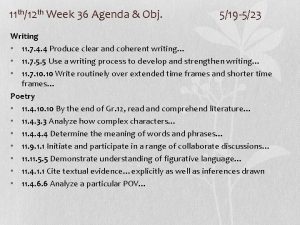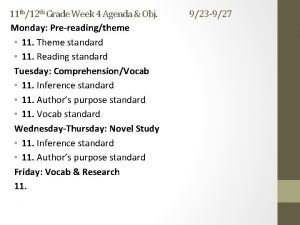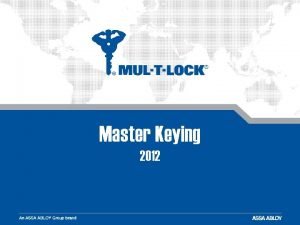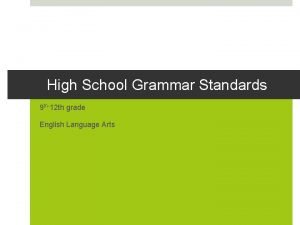Master 1 Didactics Week 09 April 5 th12




























- Slides: 28

Master 1 Didactics Week 09: April 5 th-12 th: THE ROLE OF CULTURE IN TEACHING AND LEARNING ENGLISH AS A FOREIGN LANGUAGE

Aims: - Definition of culture. - Culture and its relationship with language. - What role does culture play in teaching and learning English as a foreign or second language? - How to teach culture in English language classroom.

1. Introduction Language is a means of expression. We express our feelings, emotions, thoughts, needs, desires etc. in words, symbols and gesture which is considered as language. Language can be defined as verbal, physical, biologically innate, and a basic form of communication. Culture is the characteristics of a particular group of people, defined by everything from language, religion, cuisine, social habits, music and arts. Thus culture finds its expression in language; so, learning a new language without familiarity with its culture remains incomplete. Is it necessary to learn about the culture of the target language to acquire English as a foreign or second language.

There are four views regarding the teaching of culture. The first one states that ‘target language culture’ should be taught along with English to acculturate language learners into the cultures of English speaking countries (Byram, 1990; Byram & Flemming, 1998). The second view states that there should not be any teaching of the ‘target language culture’ together with English in the countries where English is an institutionalized variety (Kachru, 1985, 1986; Kachru & Nelson, 1996; Canagarajah, 1999). Other two views also reject the idea of teaching ‘target language culture’ along with English. However, while one of the views supports the teaching of ‘local culture’ in English language teaching (Kramsch & Sullivan, 1996; Mc. Kay, 2003), the other view holds the position that English has become a lingua franca and it should be taught in a culture-free context (Alptekin, 2005; Jenkins, 1996, 2000, 2002, 2005; Seidlhofer, 2001).

2. Culture The word culture has many different meanings. For some it refers to an appreciation of good literature, music, art, and food. For a biologist, it is likely to be a colony of bacteria or other microorganisms growing in a nutrient medium in a laboratory. However, for anthropologists and other behavioral scientists, culture is the full range of learned human behavior patterns. The term was first used in this way by the pioneer English Anthropologist Edward B. Tylor in his book, Primitive Culture, published in 1871. Tylor said that culture is "that complex whole which includes knowledge, belief, art, law, morals, custom, and any other capabilities and habits acquired by man as a member of society. "

Culture is the characteristics of a particular group of people, defined by everything from language, religion, cuisine, social habits, music and arts. Cultures are what make countries unique. Each country has different cultural activities and cultural rituals. Culture is more than just material goods, that is things the culture uses and produces. Culture is also the beliefs and values of the people in that culture. Culture also includes the way people think about and understand the world and their own lives. Culture can also vary within a region, society or sub group.

3. Importance of culture in language teaching • Wei (2005: 56) language has a dual character: both as a means of communication and a carrier of culture. • Brown (1994: 165) 'A language is a part of a culture and a culture is a part of a language; the two are intricately interwoven so that one cannot separate the two without losing the significance of either language or culture'. • Gao (2006: 59) - The interdependence of language learning and cultural learning is so evident that one can conclude that language learning is culture learning and consequently, language teaching is cultural teaching.

-language teachers should be aware of the place of cultural studies in foreign language classroom and attempt to enhance students' cultural awareness and improve their communication competence. • Wang (2008) Foreign language teaching is foreign culture teaching, and foreign language teachers are foreign culture teachers'. • Tomalin (2008) -The international role of the English language and globalisation are the two main reasons to teach culture as a fifth language skill, in addition to listening, speaking, reading and writing. 'What the fifth language skill teaches you is the mindset and technique to adapt your use of English to learn about, understand appreciate the values, ways of doing things and unique qualities of other cultures.

-Teaching of culture in ELT should include cultural knowledge (knowledge of culture's institution), cultural values (the 'psyche' of the country, what people think is important), cultural behaviour (knowledge of daily routines and behaviour), and cultural skills (the development of intercultural sensitivity and awareness, using English language as the medium of interaction. ) 4. Cultural Influence on Foreign Language Teaching -to what extent does cultural background knowledge influence language learning and teaching? - how can we take advantage of that influence? - What roles does culture play in language learning and teaching?

4. 1. Cultural Influence on Vocabulary Language is the carrier of culture Vocabulary is the basic ingredient of language The cultural difference will inevitably be exhibited on the vocabulary, and the explanation of vocabulary will also reflect the national or cultural difference. Take colour as an example. In Chinese, white, denoting a colour, often associates with “pure, noble and moral goodness”, and the bride is dressed in white during the wedding in most western countries. In China the bride must wear red in the traditional wedding, definitely not white. Because Red means “happiness, good luck, flourishing and prosperous” in the future and people only wear white in funerals when one’s family member or relative is dead. White in China, is associated with “pale, weak and without vitality”.

Understanding listening materials involves: - English level - intellectual range - analytical ability - imaginative ability - cultural background knowledge of English (most important) It will be difficult for us to understand, if the materials we are listening to are closely related to the cultural background knowledge we are not familiar with. Sometimes the materials may be easy and we can get the pronunciation of each word, but the lack of necessary cultural background knowledge may hinder our thorough understanding.

4. 3. Cultural Influence on Speaking To be able to speak involves not only: -Knowledge of the linguistic aspect of the target language But also: -Understanding of the cultural background knowledge of the target language In the course of oral communication, speakers should pay much attention to the context, i. e. what you are saying, to whom you are saying it, when and where you are saying it, etc. So, in the training of oral English, teachers should emphasize the practical use of the language, and try to use the materials which come from the daily life.

4. 4. Cultural influence on reading interpreting a piece of written discourse involves : - the knowledge of the target language, - the cultural differences between the target language and the readers’ mother tongue. Linguistic knowledge can affect one’s reading, but cultural factors play a more important role in the reading process, most of the true and serious reading barriers are not only from the language knowledge itself, but also caused by the cultural differences between the target language and our mother tongue.

4. 5. Cultural Influence on Translating In translating, we should have enough knowledge about both the target and the source language. The difficulty in translation mainly lies in the understanding of cultural background knowledge. The cultural background knowledge includes many aspects, such as art, history, geography, philosophy, science, etc.

5. Teaching culture in EFL Classroom • Kramsch (1993) “A foreign culture and one's own culture should be placed together in order for learners to understand a foreign culture. ” • (Wang, 2008: 4) “Making students aware of the important traits in the target culture help them realise that there are no such things as superior and inferior and there are differences among people of distinctive cultures, as well. ” • ( Straub, 1999) “Educators should always have in mind when teaching culture is the need to raise their students’ awareness of their own culture and 'the target culture. ”

• (Coleman, 1996; Holliday, 1994; Mc. Kay, 2002) “Teachers and program developers are asked to take the learners' sociocultural background into consideration in choosing materials and pedagogical approaches for particular contexts of teaching. ” • (Eisenstein and Bodman, 1986, 1993) “Mastering in a language requires learners' mastery of the cultural contexts in which important social acts occur because it conveys warm feelings and solidarity among interlocutors and is categorized in the 'social' use of language. ” • (Liddicoat, 2000: 51 ) “Language learners need to understand what native speakers mean when they use the language, even if they do not choose to replicate native speakers' behaviour. ”

5. 1. Guidelines for Teaching Culture • Lessard-Clouston (1997) “ It is important to develop knowledge about target culture together with skills necessary for mastering communication and behavior in the target culture. ” “Cultural awareness is necessary for developing learner’s understanding of the dynamic nature of the target and learner’s own culture. ” “Teachers must adopt systematic and structured approach as the learners benefit most when the lessons and the cultural aspects of language teaching are well planned and developed. ” “Culture learning assessment is a part of learning process and provides important feedback to learners as well as to teacher. ”

“Teacher helps learners to express and respond to their cultural learning experiences. Learners move through the stages of learning cycle building skills, developing cultural behavior, discovering cultural explanation. ” The teacher’s role • Teacher needs to establish a good working relationship with learners, “creating an atmosphere of mutuality and respect; ” • He needs to be versatile; • he has to present and elicit cultural information, • he has to coach and model cultural behaviors; • he has to guide and conduct cultural research and analysis; • teacher should share his own cultural experience with learners to help them enter another culture; • he needs to supplement learners with core materials to integrate cultural objectives into the learning process; • he needs to be aware of the fact that every child is individual and has his own cultural identity; • he needs to encourage active reflection and cultural comparison; • he needs to develops metacognitive awareness which includes cultural awareness

5. 2. Techniques for Developing Cultural Awareness • (O’Dowd, 2004) “Literature and drama have been found to be very effective for making learners sensitive to alternative cultural perspectives. ” • ((Planet, Byram 1999) “Teachers need to start with reflecting on learner’s own culture and only later introduce the target culture. ” “Intercultural Competence can be developed by comparative approach which, should “provide a double perspective but not to evaluate to see which is better. ” • (Hughes in Valdes 1986). “Culture assimilators are supposed to be a good method to promote understanding of cultural information and emotional empathy. ” • (Bowen 2005). “Audio motor Unit or Total Physical Response, designed as a listening exercise, employs a carefully constructed list of oral commands to which students respond. These commands are arranged in such a way to make students act out a cultural

6. Teaching Materials for cultural awareness • (Durant 1997) lists out nine sources of materials: - Interaction with members of the target culture, - recorded testimony of members of the target culture, - visits to the country, - the country’s media, - data from ethnographic fieldwork, - historical and political data, - surveys and statistics, - heuristic contrasts, - oppositions to fashions and styles from the target country.

6. 1. Foreign Language Textbooks and Intercultural Learning • (Pulverness 2004: 28) - Textbooks serve as a rich source of topics, texts, visuals and language as well as help to form syllabus of the course. - Textbooks used in English lessons are primarily designed to facilitate foreign language learning but because of interrelation of language and culture, textbooks are expected to include some aspects of target language culture as well. • (Kramsch 1994) To become fluent in the L 2/FL, communicative competence is needed. It covers a cultural understanding of social behavior, routines and discourse nuances as well as society’s norms and values.

- It establishes requirement for FL textbooks to include accurate representation of the target language culture. • (Skopinskaja 1992: 42) - There are two types of textbooks currently used: international or global and locally produced textbooks: International or global textbooks are produced with international market in mind; it means that these textbooks are written to be as universally appealing as possible. They usually focus only on the target culture and international level of encounters. These textbooks can represent either culture-specific or culture-general orientation. Locally produced textbooks, on the other hand, are written by non-native authors or in cooperation with non-native speaking authors. These textbooks are usually written in accordance with national curriculum and have approval of Ministry of Education of particular country. Being written by local authors, they tend to introduce target culture from local perspective and usually also include some aspects of local culture.

• Camillery, Fenner in Newby 2000: 154) The structure of culture teaching in textbooks should integrate knowledge, sociocultural competence and attitude so as to reflect real life situation where “gaining knowledge usually happens simultaneously with the ability to use this knowledge and develop attitudes related to it. ” • (Pulverness 2004) Cultural information can be conveyed through written or oral texts, photographs, maps, graphs, etc. Gaining knowledge serves as a basis for developing sociocultural competence. There are various approaches to it but as sociocultural competence is a process it must be developed through process approach. Pulverness claims the importance of the comparative method in the learning process. This method, recommended by many scholars, employs analysis, comparison and contrast to be included in the treatment of culture content in textbooks.

• O’Dowd 2004: 66) “Textbook in order to be effective has to include role-plays, project work and other activities which teach how to analyze a cultural document, carry out an ethnographic research and identify cultural values and perspectives encoded in target culture. ”

6. 2. Other Resources • (Ellis 2003) Use of authentic materials is rewarding and stimulating for both learners and teachers and should be used as far as possible. It is commonly used with higher level students but can be equally used with lower levels. Traditional songs, rhymes, riddles, and other children’s lore are ideal for younger children • (Newby 2000). Authentic materials not only include newspapers and literature but also materials such as web pages, TV broadcasts, films, leaflets, posters, basically anything written in the target language and used unedited in the classroom. The same material can be used in classes of various levels provided that the task is graded to learner’s abilities and interests

• (Valdes 1986: 135) Good cultural insights can readily be found in headlines, advertisements, editorials, sports pages, comics, even the weather report. Authentic children’s literature provides a rich resource for culture learning as it contains cultural information divided by Ellis and Brewster into eight categories: • (Ellis 2003: 16) - Linguistic: for example, conventions of politeness; - Geographical: for example, information on different countries, flags, capitals; - Historical: for example, information on dinosaurs; - Festivals: for example, information on Easter; - Illustrations: for example, information conveyed through illustrations; - Everyday life: information on shops and shopping, meal times; - Citizenship-related issues: for example, tolerance; - Song, music and rhymes: many traditional songs and rhymes link well to stories and provide authentic examples of children’s lore.

▪ Both cultural content and meaning can be approached in poems and plays. ▪ Films, filmstrips and slides provide cultural insights as well as welcome variety of classroom activities. ▪ Videos are a useful vehicle for learning more about the topic, for making cross-cultural comparisons and for making the language more memorable.

Conclusion Culture and language are intricately interwoven so that one cannot separate the two without losing the significance of either language or culture. If any one of them is separated the other remains incomplete. In EFL or ESL classroom, students should be taught English with the culture associated with it so that they can acquire the target language with cultural background and correspond in real life situations. Thanks for viewing
 Lumbalizacja s1 wikipedia
Lumbalizacja s1 wikipedia Tara nowakhtar
Tara nowakhtar Didactics of microlearning
Didactics of microlearning Behaviorism presentation
Behaviorism presentation Didactics
Didactics Week by week plans for documenting children's development
Week by week plans for documenting children's development 24 april 2007
24 april 2007 April fleming
April fleming April rustianto
April rustianto Pada tanggal 1 april 2011 cv seneng makmur
Pada tanggal 1 april 2011 cv seneng makmur April 4
April 4 Site:slidetodoc.com
Site:slidetodoc.com April 23 1616
April 23 1616 April spelling tic tac toe
April spelling tic tac toe Guten morgen freitag 1 april
Guten morgen freitag 1 april April christian
April christian April 28 day of mourning
April 28 day of mourning National sovereignty and childrens day
National sovereignty and childrens day April ford incentives
April ford incentives April rain song
April rain song April savoy allstate
April savoy allstate April 2006 calendar
April 2006 calendar April 6 1992
April 6 1992 April ericsson
April ericsson 27 april 2001
27 april 2001 Leonardo da vinci was born on april 15 1452 in the small
Leonardo da vinci was born on april 15 1452 in the small April reprogle
April reprogle Astronomy picture of the day 17 april 2001
Astronomy picture of the day 17 april 2001 This day in history april 15
This day in history april 15








